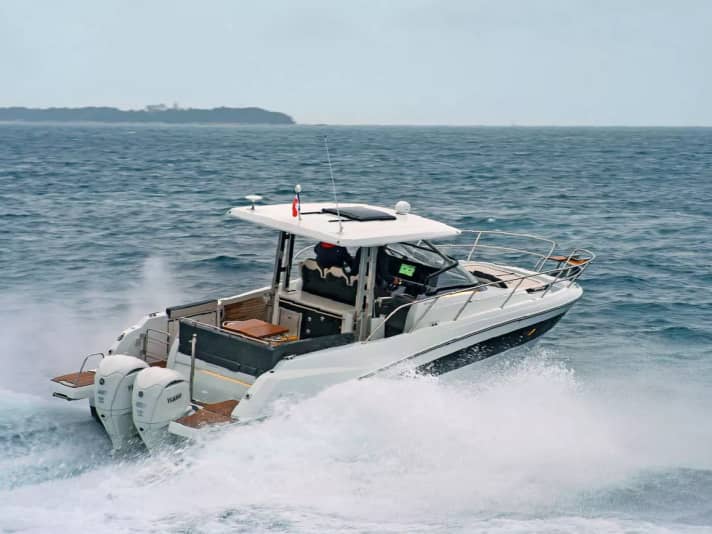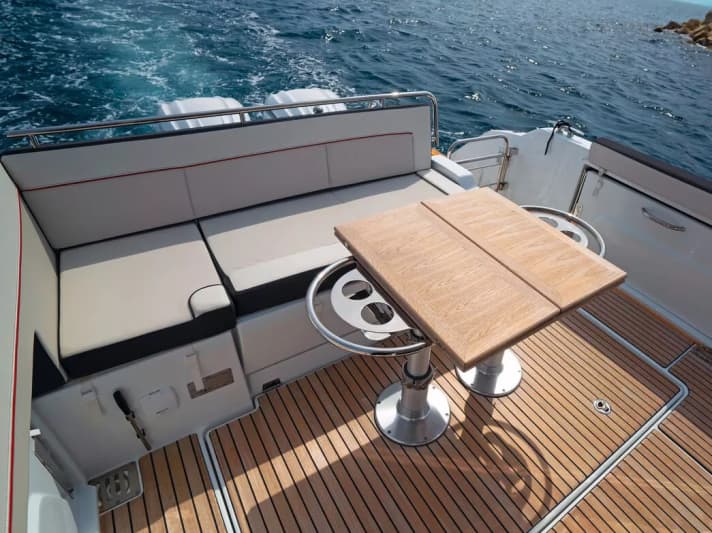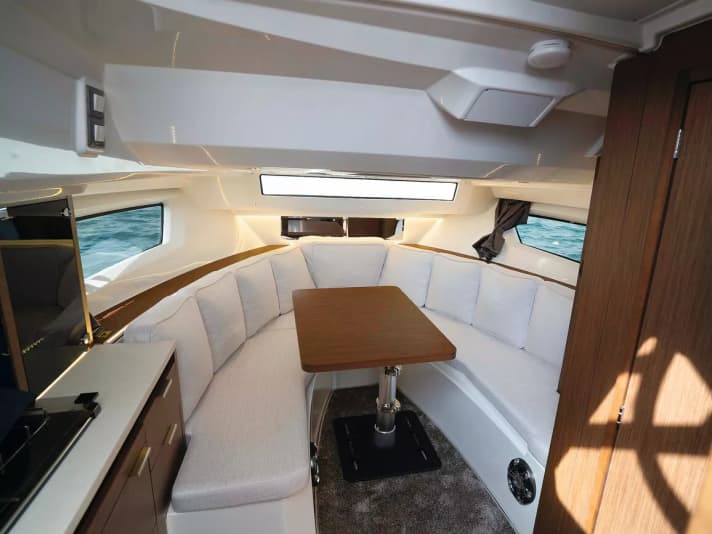
For the new edition of the Jeanneau Cap Camarat 10.5 WA, the shipyard copied the lines from its big sister, the 12.5 WA. The T-top of the two boats also have very similar shapes. However, the practical roof on our test boat costs just under 15,000 euros extra. It also has a large sliding hatch in the centre that can be opened to let the sun in if required. The driving position is located under the T-top and behind it is the leaning post, which can accommodate a total of three people.
Following the leaning post on our test boat is a galley, which is equipped with a refrigerator, gas cooker and sink (slimmed-down or other variants are possible) and of course a number of storage options. So there's everything you need to quickly prepare something during the day without having to go below deck to the galley. The seating area in the cockpit can also be customised, for example with the option of a sun lounger or a folding seat in the side wall. The highlight, however, is the outward-folding side wall on the port side: it creates a kind of terrace. A bathing ladder is the crowning glory here. The regular bathing ladder is located at the stern and can be easily reached via the entrance on the port side (with an exemplary door). A stern shower is also located in this position. But that's not all: the owner can also order a ladder with platform for the bow. Another highlight on the foredeck is the huge, comfortable sun lounger (optional). The foredeck is most easily accessed via the port side, as it is noticeably wider than the starboard side deck (0.30 m to 0.16 m).

The path below deck leads via a companionway with non-slip steps and handrail. Once down below, the galley unit with cooker, fridge and sink as well as the corresponding storage space can be found on the port side. Shortcoming: The lower drawer (right) bumps against the upholstery of the seating area when pulled out. If you want to turn the latter into a double berth, you have to pay a surcharge. The same applies to the centre cushion in the underfloor cabin, which can only be separated from the rest of the lower deck area with a curtain or a fixed wall with a door for an extra charge. The wet room is still missing: The washbasin is located in the entrance area, and the toilet/shower unit (with optional glass door in front) is located aft. Next to the toilet, which is located under a folding bench, is the pull-out shower hose.
There are suitable storage options in the lower deck area. A huge storage space in the cockpit can be found under a floor flap in the table area. The stern bench can also hold a lot of equipment. The anchor, the associated anchor winch and the chain (the last three are on the accessories list) are stored in a self-draining anchor locker in a bow fitting.
The boat
- Shipyard: Jeanneau/F
- Type: Cap Camarat 10.5 WA Series2
- CE category: B/8 persons
- Hull and deck: plastic
- Overall length (with platform): 10,93 m
- Width: 3.25 m
- Displacement (without motors): 4280 kg
- Draught: approx. 0.95 m
- Clearance height: 2.95 m
- Fuel tank: 2x 400 litres
- Water tank: 160 litres
- Cabins: 2
- Berths: 4
- Berth dimensions: Bow 2.20 m x 1.90 m; centre cabin 2.00 m x 1.77 m
- Standing height/seat height: centre cabin 2.08 m (entrance), 0.86 m (above berth); saloon 1.93/1.76/142 m; WC compartment 1.96 m; under hardtop 1.93 m,
- Cockpit size: 3.85 m x 2.80 m,
- Side deck width: 0.30 m port, 0.15 m starboard.
- Railing height: 0.70 m
- Sunbed: stern 1.32 m x 1.71 m; foredeck 1.87 m x 1.87 m
- Freeboard (to rear door): 0.70 m
- Interior cockpit side height: 0.76 m
- Maximum motorisation: Outboard 2x 313 kW (425 hp)
- Test engine: Yamaha 300 4.2 L, 2x (221 kW) 300PS
- Price (standard boat with test engines, delivery in Germany): from € 228,607
- Dealer proof: www.jeanneau.com
But now to the driver's seat: it is the centre of the three seats on the leaning post. The co-drivers are seated next to it and can hold on to well-positioned handles. From his seat, the skipper has unrestricted access to the two gearstick levers and the steering wheel. Next to the gearstick, the shipyard installs the Zipwake trim system control panel, which costs an extra charge, as do the bow thruster and Garmin plotter installed on our test boat. Plus: The compass comes as standard; Minus: The horn and windscreen wiper cost extra.
In slow, course-stable displacement sailing, we leave the harbour of Cannes and head for the Mediterranean. A little further out, we push the levers further forwards and the Jeanneau switches from displacement to planing speed between around 2000 rpm and 4000 rpm. The bow lifts moderately and lowers again when the planing speed is reached. To bring the boat into the optimum position during planing, you can use the automatic zipwake and power trim or, of course, trim the Jeanneau by hand. The Yamaha automatic system is part of the so-called pre-rigging package, which on our test boat includes electronic steering, electronic shifting, automatic trim, autopilot, colour touch display and Smart Key. The Zipwake system helps in the transition phase and is particularly useful when leaning sideways and compensating for rolling movements.

Properly trimmed, it's off to the test track. On our test day, however, the Mediterranean is quite choppy. We record the measurement results as best we can in calm water. The results show an economical planing speed of 22.1 knots at 4000 rpm. The consumption is then 3.99 l/sm and the range of 170 nautical miles is within the range we require.
The fast manoeuvres: When cornering at a good 30 knots, the hull makes a confident and balanced impression despite the waves. The skipper is also able to steer the Jeanneau safely on a slalom course and when the steering is jerky. We want to find out more and head further out, where the swell increases. Here we let the test boat jump diagonally over the wave at around 23 knots - and stay dry. We can go even faster, but then the boat gets a shower or two. Now back in the calm harbour, where the Cap Camarat 10.5 WA Series2 can be safely moored with its two engines and bow thruster. Jeanneau has installed petrol filters with a sight glass to ensure that the outboards work safely. The equipment with remote-controlled shut-off valves is also exemplary. The complete bilge system and the standard fire extinguishers also receive praise. The installations on the test boat are neatly executed and the workmanship also makes a good impression.
When it comes to accessories, Jeanneau goes the usual route and gives the owner a lot of freedom to put together their very own customised boat.

Conclusion
The Jeanneau Cap Camarat 10.5 WA Series2 is a chic boat that is perfect for travelling (four people) or comfortable day trips and swimming excursions. The latter is particularly enhanced by the "terrace" on the port side. The sailing characteristics and manoeuvrability are impressive.
You can find the test of the Jeanneau Cap Camarat 10.5 WA Series2 with more pictures and full test results in BOOTE issue 09/2022 - available from newsagents from 17 August 2022 or online in the Delius Klasing Shop.

